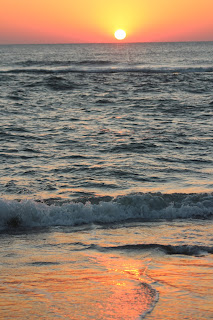We woke up without an alarm and made it to the beach in time for a beautiful sunrise.
These house are where the lighthouse keepers and their families lived.
These stones are the original for the lighthouse. Each stone contains the name of a lighthouse keeper. Now they form amphitheater for ranger talks.
Strict social distancing and masks were enforced so while we were waiting to go into the house, the volunteer told us about a beach where shells could be found. So far we had not found one shell so we decided to make a little detour to that beach to shell hunt. We are glad we did because we found lots of shells. They are mostly clam shells but we were happy to find even clam shells.
The shelling was an extra bonus but we felt it was worth it. Next stop was the free ferry to Ocracoke Island. This is where plans began to fall apart. We waited for two hours for the ferry. Someone in line told us that there are normally three ferries and they run every 30 minutes but today, one is being repaired. It was just our luck! We also didn't realize that it is a one-hour ride to Ocracoke Island. We arrived at the island a little after four and drove to the lighthouse we had come to see. The Ocracoke Lighthouse sits at the end of a narrow road at the end of the Village of Ocracoke. The brochure telling about the lighthouse said that parking was limited and that was the truth...only four spots and many more than four cars looking for spots. We drove by, turned around, and snapped this picture on the second pass by the lighthouse.
The village of Ocracoke is very small but it contains more golf carts and restaurants than the total population. The speed limit through the town was 20 MPH to accommodate the golf carts on the highway. By the time we got through the town we were ready to head for the ferry. There was one more stop and that was to see the ponies of Ocracoke Island.
These ponies were brought to the island on Spanish ships in the 1500's. They were used as transportation, cart pullers, etc. Eventually, they became wild and wandered the island. In the 1960's the national park service was afraid they would be killed by motorists so they took control of the horses, building fences to contain them, and feeding and caring for them. The herd has dwindled from 300 to only 17 remaining.

















No comments:
Post a Comment